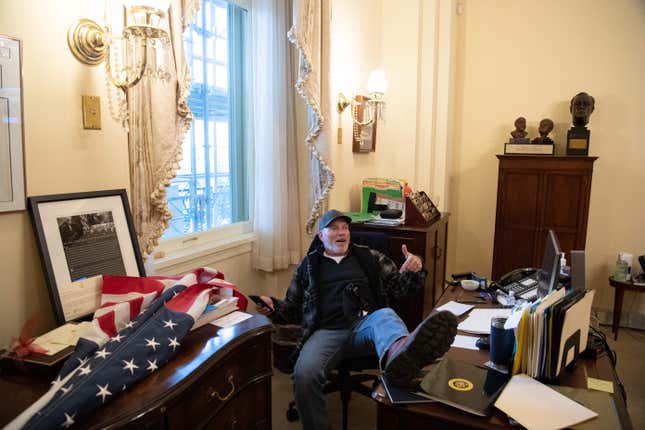
Image: Saul Loeb
“Where are you, Nancy? We’re looking for you,” says a voice belonging to one of the January 6 Capitol insurrectionists. “Nancy. Ohhh Nancy,” he continues in a singsong voice as he walks down a hallway. The video, included in house manager Stacey Plaskett’s Wednesday presentation during Trump’s second impeachment trial, was part of a larger narrative outlining how insurrectionists actively targeted members of Congress, particularly Nancy Pelosi. Photographs of Richard Barnett, one leg stretched out on Pelosi’s desk in a gesture of performative ownership, are already familiar as part of the insurrection’s iconography but, as Plaskett made clear, Barnett’s behavior was representative of a rooted violence animated by misogyny.
“Crazy Nancy,” Trump’s favorite nickname for Pelosi, Plaskett reminded the Senate, was repeated so often that even members of the media became numb to its blunt misogyny. Trump’s relentless focus on Pelosi, however, wasn’t particularly new; it’s moved the right for some time, particularly those politicians who owe their power to the Tea Party. That Majorie Taylor Greene liked a Facebook comment that fantasized a “bullet to the head” for Pelosi should have surprised no one. The conservative rhetoric that’s coalesced around Pelosi is rich with violence and revels in misogyny. Trump seized on that, making sexism part and parcel of his political grievances. His supporters gleefully chanted “lock her up” at both Hillary Clinton and Ilhan Omar, and shared heavily doctored videos to make Pelosi look incapacitated (he used a similar strategy for Clinton).
But misogyny, of course, was always part of Trump’s appeal. Even prior to his election, Trump had been accused of sexual misconduct by numerous women and the infamous Access Hollywood tape reaffirmed precisely what Trump believes. His words—“grab them by the pussy”—were dismissed as nothing more than the typical talk of boys in a locker room, the kind of jests that make men real men. The excuses were flimsy, of course, but they didn’t need to have substance, they simply needed to reaffirm to Trump’s most ardent supporters such behavior wasn’t sexist but simply the natural state of white masculinity. Trump simply took what belonged to him by right. Those who criticized, let alone stood in the way, were the enemy. Pelosi, as much as Clinton, became the focus of such ideology.
His supporters flocked to a rally, believing that a victory had been stolen from them, and then later charged the Capitol, carrying Trump flags and wearing MAGA hats, in the name of a man who has been accused of sexual harassment, assault, and rape by at least 25 women. It is a striking but understated fact. For that reason alone, it came as little surprise a man who has dedicated his life to harassing women at a West Virginia abortion clinic was among the rioters. It came as even less of a surprise that, as HuffPost reported this week, nine of the insurrectionists “who stormed the Capitol have a history of violence against women―ranging from domestic abuse accusations to prison time for sexual battery and criminal confinement.” Those nine include Guy Reffit, a right-wing militia member who strangled his wife; Edward Hemenway who served five years for rape after he “lured his estranged wife to a hotel in 2004 where he handcuffed her and duct-taped her mouth shut”; and a Proud Boy with a history of violence against his family.
These are the people who sought out Pelosi, breaking into her office, singing “Oohhh Nancy.” The same people who terrified Alexandria Ocasio-Cortez and threatened Rashida Tlaib’s life. The January violence—what Plaskett called the “sacking of the Capitol”—was generically political, of course, aimed at anyone named as an enemy by Trump, anyone who would not enact his every whim. That included Republicans like Mike Pence and Mitt Romney. But as Wednesday’s presentation showed, the lifeblood of this violence was misogyny, and Pelosi the most obvious outlet for its expression.
After Richard Barnett took his boot off Pelosi’s desk and exited her office, he said in an interview that he left her a note. According to Barnett, it said, “Nancy, Bigo was here, you bitch!” (Bigo is Barnett’s nickname.) Barnett was given exactly what Trump promised, enacting revenge on the enemy in the most uncreative terms possible (sexism is always extraordinarily unimaginative). Seeing Plaskett piece this together, video clip by video clip, was unsettling but not surprising. “Where are you, Nancy?” will ring in my ears for days but it will only replace the other iterations of gendered violence (Crazy Nancy, “lock her up, “low IQ,” “that woman,” etc) that have rung in them for years.